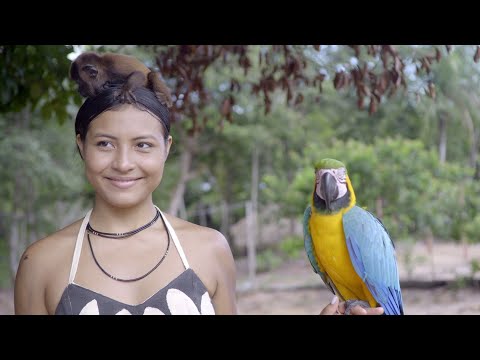Traditionally, indigenous populations of the Venezuelan Amazon, which were mostly nomadic until a few decades ago, applied ancestral agricultural techniques that helped preserve the forest due to their seasonal rotation.
Today, most of those formerly nomadic communities have settled permanently. They continue to grow their produce in fixed locations resulting in significant land degradation in some areas, and mass shelling of trees in others.
To prevent this, since 2010, SGP has been supporting a project that aims at the promotion of participative management for the sustainable development of agro forestry systems and food production to help preserve the natural resources of the forest while achieving food security for the indigenous populations of the Venezuelan Amazon, specifically the Piarora community of Gavilán.
During the first stage of this project (2011-2012), 128 people belonging to 15 families received support for the construction and maintenance of plant nurseries and agroforestry land patches. This represents the sustainable management of 12 ha. Each of these plant nurseries can produce up to 2,000 plants each year, of more than 13 autochthonous species. These include annual crops such us: yucca, sweet potato, mapuey, name, ocumo; the biannual crops like pineapple and tupiro and the semi-perennial like guama, cocura and temare); as well as the perennial varieties such us copoazu, pijiguao and anon. An average of approximately 4,000 plants per hectare per family have been planted so far for a total of 10,000 plants in 12 hectares.
In terms of biodiversity, the impacts of the project are the diversification of productive units, through the utilization of agro-forestry, as a method of in situ conservation of species with the potential for food production. In terms of land degradation, the benefits include avoiding further deforestation of virgin forests for the establishment of new patches in the watershed of Cataniapo River, and the creation of sustainable crops in previously intervened and degraded areas.
As a result, during the first year of the project, the Piaroa community produced between 2,000 and 5,000 Kg/ha of the main annual crops (roots and tubers such as yucca, sweet potato, mapuey and acumo). These have been used to satisfy local food needs, as well as for trade in the Puerto Ayacucho markets (in the capital city of the Amazonas state). This is in great contrast to the previous food production that was greatly affected by the poor yields of the patches and resulted in very low income for the community (in most cases it was not even enough to trade).
The active participation of the Gavilán community was a determining factor in achieving the project objectives, especially those implementing sustainable agricultural practices that contributed to: i) Reduced fragmentation of forests and wildlife corridors, ii) Diminished soil erosion and sedimentation of water sources, iii) Recovered areas with different levels of biophysical degradation; iv) Avoiding the establishment of crops near river banks, v) Diversifying, increasing and preserving autochthonous crops, vi) Rescuing traditional knowledge about land use and biodiversity, vii) Improving sustainable local livelihoods through trade.
The project was possible thanks to the valuable support of the GEF Small Grants Programme, implemented by UNDP which approved a grant for USD 46,620. In addition, the project was able to leverage USD 60,000 in kind and in cash contributions from of the Gavilán community and Fundación Probiodiversa.
Furthermore, members of neighboring communities of Sardi, San Pablo and San Pedro de Cataniapo have taken part in the Project activities in Gavilán and have requested support from the Foundation and local government of Amazon state to replicate this project in their communities.
Background for editors
About the GEF
The GEF unites 182 countries in partnership with international institutions, civil society organizations (CSOs), and the private sector to address global environmental issues while supporting national sustainable development initiatives. Today the GEF is the largest public funder of projects to improve the global environment. An independently operating financial organization, the GEF provides grants for projects related to biodiversity, climate change, international waters, land degradation, the ozone layer, and persistent organic pollutants.
Since 1991, GEF has achieved a strong track record with developing countries and countries with economies in transition, providing $10 billion in grants and leveraging $47 billion in co-financing for over 2,800 projects in over 168 countries. Through its Small Grants Programme (SGP), the GEF has also made more than 13,000 small grants directly to civil society and community-based organizations, totaling $634 million. For more information, visit www.thegef.org.
About the GEF Small Grants Programme
Launched in 1992, SGP supports activities of nongovernmental and community-based organizations in developing countries towards climate change abatement, conservation of biodiversity, protection of international waters, reduction of the impact of persistent organic pollutants and prevention of land degradation while generating sustainable livelihoods.
Since its creation SGP has provided grants to 12,000 communities in 122 developing countries. Funded by the Global Environment Facility (GEF) as a corporate programme, SGP is implemented by the United Nations Development Programme (UNDP) on behalf of the GEF partnership, and is executed by the United Nations Office for Project Services (UNOPS).
Media contacts:
Ana Maria Currea, Knowledge Management Facilitator, GEF SGP,
ana.maria.currea@undp.org, 646-781-4353
John Diamond, Senior Communication Officer& Spokesperson
Global Environment Facility
jdiamond@TheGEF.org, (202) 458-7953
This GEF SGP project is helping to preserve the natural resources of the forest while achieving food security for the indigenous people of the Venezuelan Amazon.


